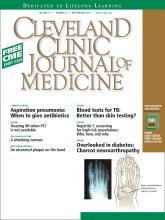Table of Contents
From the Editor
- Exchanging the skin bleb for the test tube
New blood tests are a positive step towards accurate recognition and treatment of patients with latent tuberculosis.
Editorial
- Timeliness of treatment is more important than choice of reperfusion therapy
The most important modifiable predictor of outcome in ST-segment elevation MI is the time to treatment, a biological truth that continues to be supported by clinical evidence.
1-Minute Consult
- Are antibiotics indicated for the treatment of aspiration pneumonia?
Yes, for primary bacterial aspiration pneumonia and secondary bacterial infection of aspiration (chemical) pneumonitis, but not for uncomplicated chemical pneumonitis.
The Clinical Picture
- The shrinking woman
A 45-year-old woman on dialysis has lost 20 cm in height over the past 8 years, despite two parathyroidectomy procedures. Would a third one help?
- An ulcerated plaque on the hand
A 73-year-old farmer has a lesion on the dorsum of his hand that bleeds intermittently. What is it?
Review
- Charcot neuroarthropathy: An often overlooked complication of diabetes
Suspect this condition if a patient with long-standing, poorly controlled diabetes and peripheral neuropathy develops a red, hot, swollen foot without ulceration.
- Interferon-gamma-release assays: Better than tuberculin skin testing?
These new blood tests overcome some of the limitations of skin testing, but converting to them poses challenges.
- Hepatitis C virus: Prevention, screening, and interpretation of assays
Patients at risk of hepatitis C virus infection should be screened for it so that they can be treated and potentially cured, or can at least avoid transmitting the disease to others.
- Combined reperfusion strategies in ST-segment elevation MI: Rationale and current role
In geographic areas where percutaneous coronary intervention (PCI) is not immediately available, the best strategy may be to give thrombolysis immediately and then to transfer the patient to a PCI hospital.




